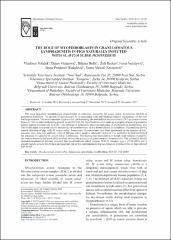The role of myofibroblasts in granulomatous lymphadenitis in pigs naturally infected with M.avium subsp.hominissuis

View/
Date
2018Author
Polaček, Vladimir
Vidanović, Dejan
Božić, Biljana
Becskei, Zsolt
Vučićević, Ivana
Prodanov-Radulović, Jasna
Aleksić-Kovačević, Sanja
Metadata
Show full item recordAbstract
The most important morphological characteristic of infections caused by M. avium subsp. hominissuis (MAH) is
granuloma formation. The growth of mycobacteria is in accordance with anti-bacterial effector mechanisms of the host
within granuloma. The most important cytokines for „orchestrating“the host defense are interferon ă (INF-ă), tumor necrosis
factor á (TNF-á) and transforming growth factor â1 (TGF-â1). Myofibroblasts that make up a peripheral layer of granuloma
largely express receptors for TGF-â1. This cytokine is believed to affect the induction of myofibroblast proliferation. The
aim of this paper is to point out the importance of myofibroblasts in the formation and sustainability of granuloma during
natural infection of pigs with M. avium subsp. hominissuis. Examinations have been performed on the samples of Lnn.
jejunales, Lnn. ileocolici and Lnn. colici of 100 pigs with a positive tuberculin skin test. The molecular method confirmed
the presence of a genome M. avium subsp. hominissuis. The microscopic examination of lymph node samples stained by
the routine hematoxyilin-eosin (HE) method, showed the presence of granulomatous lymphadenitis. The method of double
immunohistochemical staining revealed that myofibroblasts which express TGF-â1 receptor type I (TGF-â1RI) and á
smooth muscle actin (á SMA) have an important role in the morphogenesis of granulomatous lymphadenitis in pigs infected
with MAH.
